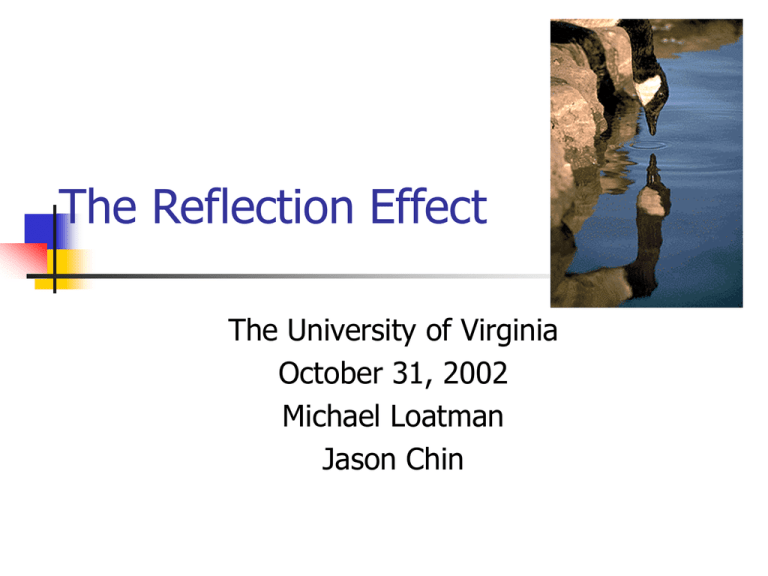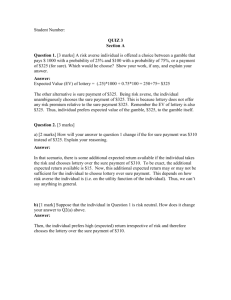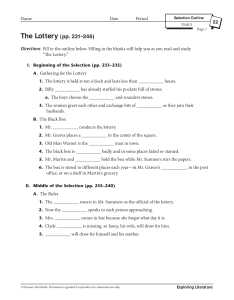The Reflection Effect - Faculty Virginia
advertisement

The Reflection Effect The University of Virginia October 31, 2002 Michael Loatman Jason Chin Simpsons Example Marge starts off being risk averse. “I'm not wild about these high-risk ventures. They sound a little risky.” “Look at them! They've jumped on the one franchise I might possibly have considered thinking about becoming interested in.” Like our participants, she began to rake in the money. When faced with losses from the mob, she became risk seeking. "We're going to do what we do everyday. We're going to make pretzels!" Background Reference Point I. A. II. III. IV. Loss aversion and reflection effect Kahneman and Tversky experiment (1979) Holt and Laury critique (2002) Chin-Loatman critique (2002) Reference Point Reference Point Loss aversion Point where gains and losses are evaluated Implies that losses are given more weight in choices with outcomes that involve both gains and losses Reflection effect Postulates that risk aversion exhibited by choices when all outcomes are gains will be transformed into a preference for risk when all outcomes are losses Kahneman and Tversky (1979) Took the following lottery choice experiment Lottery S (selected by 80%) Lottery R (selected by 20%) 3,000 with probability 1.0 4,000 with probability 0.8 0 with probability 0.2 and reflected it around zero to get losses Kahneman and Tversky con’t Resulting in Lottery S (selected by 80%) Lottery R (selected by 20%) minus 3,000 with probability 1.0 minus 4,000 with probability 0.8 0 with probability 0.2 Experimenters found people were risk averse with positive payoffs and risk seeking with negative payoffs Experiment used hypothetical payoffs, did this skew results? Holt and Laury Critique Made changes to Kahneman and Tversky design Used real incentives Allowed participants to earn an initial stake, a higher one in the loss condition to hold final wealth constant Reflected the payoff menu from Chapter Four around zero Holt and Laury Cont’d Payoff menu Option A Option B Decision 1 $40.00 if throw of die is 1 $32.00 if throw of die is 2-10 $77.00 if throw of die is 1 $2.00 if throw of die is 2-10 Decision 2 $40.00 if throw of die is 1-2 $32.00 if throw of die is 3-10 $77.00 if throw of die is 1-2 $2.00 if throw of die is 3-10 Decision 3 $40.00 if throw of die is 1-3 $32.00 if throw of die is 4-10 $77.00 if throw of die is 1-3 $2.00 if throw of die is 4-10 $40.00 if throw of die is 1-10 $77.00 if throw of die is 1-10 … Decision 10 Holt and Laury Critique Cont’d Results Different from what K & T found Instead of a strong reflection effect, found that in general people were risk neutral in the loss domain and risk averse in the gain domain. Chin-Loatman Critique Our intuition about why Holt and Laury’s data did not match previous researchers’ data is because Holt and Laury did not offer a risky choice with a possibility of a loss of $0. Procedure We used the Lottery Choice veconlab program just as Holt and Laury did. EXCEPT we changed the risky payoff of $0.10 to $0. The first four rounds allowed the participants to gain a large amount of money using scale factors of 1, 45, 90, and 90. This was important since we wanted to make sure the participants would have a decent amount of money to want to protect. The last four rounds were reflected around zero and thus used scale factors of –1, -45, -90, and –90. Payoff Matrix Holt-Laury Chin-Loatman Gains (Scale Factor = 1) Safe Lottery $2.00 or $1.60 Risky Lottery $3.85 or $0.10 Safe Lottery $2.00 or $1.60 Risky Lottery $3.85 or $0 Losses (Scale Factor = 1) Safe Lottery -$2.00 or -$1.60 Risky Lottery -$3.85 or -$0.10 Safe Lottery -$2.00 or -$1.60 Risky Lottery -$3.85 or $0 Gains (Scale Factor = 90) Safe Lottery $180.00 or $144.00 Risky Lottery $346.50 or $9.00 Safe Lottery $180.00 or $144.00 Risky Lottery $346.50 or $0 Losses (Scale Factor = 90) Safe Lottery -$180.00 or -$144.00 Risky Lottery -$346.50 or -$9.00 Safe Lottery -$180.00 or -$144.00 Risky Lottery -$346.50 or $0 A Risk Neutral Person (Gains) p 0.1 0.2 0.3 0.4 0.5 0.6 0.7 0.8 0.9 1 Option A $180 or $144 Option B $346.50 or $0 147.6 34.65 151.2 69.3 154.8 103.95 158.4 138.6 162 173.25 165.6 207.9 169.2 242.55 172.8 277.2 176.4 311.85 180 346.5 A risk neutral person would pick the option with the higher expected payoff, hence 4 safe choices and 6 risky choices (in bold). Risk averse chose more than 4 safe choices. What the class did (gains) % Safe Choice Round 3, payoffs scaled x 90 1.2 1 0.8 0.6 0.4 0.2 0 observed risk neutral 1 2 3 4 5 6 7 8 9 10 Round •We see risk aversion •There is an incentive effect—the greater the payoffs, more risk aversion (not pictured) A Risk Neutral Person (Loss) p 0.1 0.2 0.3 0.4 0.5 0.6 0.7 0.8 0.9 1 Option A -$180 or -$144 Option B -$346.50 or $0 -147.6 -34.65 -151.2 -69.3 -154.8 -103.95 -158.4 -138.6 -162 -173.25 -165.6 -207.9 -169.2 -242.55 -172.8 -277.2 -176.4 -311.85 -180 -346.5 A risk neutral person would pick the option with the lower expected loss, hence 6 safe choices and 4 risky choices (in bold). The scale factor does not change the number of safe/risky choices a risk neutral person would make. A risk seeking person would chose less than 6 safe choices. % safe choice Class results (losses) 1.2 1 0.8 0.6 0.4 0.2 0 observed risk neutral 1 2 3 4 5 6 round 7 8 9 10 Results Gains Spanky Risk Averse Kemp Risk Averse Oh Canada Risk Neutral Alexis Risk Averse Soupy Risk Seeking Jmarsha Risk Averse XC Risk Averse Jenamy Risk Neutral S Risk Averse Lins Risk Averse CavMan Risk Neutral Plankto Risk Averse Losses Risk Seeking Risk Seeking Risk Seeking Risk Seeking Risk Seeking Risk Seeking Risk Seeking Risk Seeking Risk Seeking Risk Averse Risk Neutral Risk Seeking Profit -$48.90 $155.30 $277.10 $199.40 $233.40 $405.70 $358.35 $418.85 $149.25 $433.40 $524.85 $392.10 Why Are People Risk Seeking in Losses? Decision 5 Option A Option B -$180.00 if throw of die is 1-5 -$144.00 if throw of die is 6-10 -$346.50 if throw of die is 1-5 -$0.00 if throw of die is 6-10 It is hard to judge why because we are human and it seems normal to us. Psychologists, Daniel Kahneman and Amos Tversky studied these effects and came up with the most popular theory used to describe them, Prospect Theory. Kahneman & Tversky They ask people: Imagine an outbreak of an unusual disease expected to kill 600 people and you must choose between two public health programs to combat it. Kahneman & Tversky Scenario 1: If you pick Program A, 200 people will be saved with 100% certainty. If you pick Program B, there is a 1/3 chance of saving all 600 lives and a 2/3 chance of saving no lives. The expected values are the same, but people choose A, the sure thing most of the time, exhibiting risk aversion. Kahneman & Tversky If you reframe the last question in terms of losses (deaths). If you choose program A, 400 people will die with 100% certainty. If you choose program B, there is a 1/3 probability that no one will die, and a 2/3 probability that 600 will die. The question is the same as before, but framed in terms of losses. Now people tend to pick Program B, thus exhibiting risk seeking behavior Kahneman & Tversky Kahneman & Tversky say that people treat gains and losses differently. There is a reflection effect as we saw, people are risk averse in gains and risk seeking in losses They also show loss aversion, saying that losses loom larger than gains. For example: most of us would have no interest in a gamble that yields a 50% chance of gaining or losing $100. Applications and New Horizons Economist George Loewenstein applies loss aversion to his theory, the endowment effect In one study he gives mugs to half of his class, and at the end of the class takes them back. When asked how much they would pay to buy a mug, the students who once had the mug would pay more than those who never owned the mug So, having something and losing it makes you value it more. Evidence for loss aversion. Conclusion Our study shows evidence for the reflection effect There are a lot of applications of loss aversion and the reflection effect to be explored








